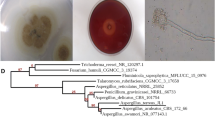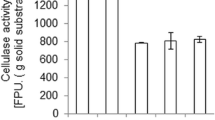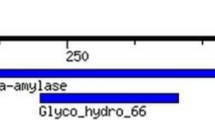Abstract
Hydrolytic enzymes from fungi have been widely used to convert complex plant-based substrates into more suitable fermentation substrates. Recently, photosynthetic microorganisms, particularly cyanobacteria, are garnering interest as an alternative to plant-based biomass for renewable energy production. Our goal was to identify a new source of enzymes with improved amylolytic efficiency in cyanobacterial glycogen hydrolysis. We isolated a new Trichoderma species J113 strain from the coastal terrains of Korea and determined that the fungus has a high amylolytic enzyme activity. We cultured the fungus on wheat bran to stimulate enzyme production, and the crude extract was subsequently purified through filtrations, precipitation, and chromatography. We observed that J113 enzyme consists of two putative major amylases: Ayt40 and Ayt70, that were determined as an α-amylase and a gluco-amylase, respectively. While these two amylases exhibited different pH and temperature requirements for optimum performance, collectively J113 enzyme showed the highest activity at pH 4 and 60 °C. In addition, we were able to drastically enhance the amylolytic capacity of Ayt70 gluco-amylase by 291 % with 5 mM Mn2+ amendment. Significantly, J113 enzyme converted 20 g/L (10 g total carbohydrate) of Arthrospira maxima to 8.3 g/L of reducing sugar with Mn2+ compared to only 5.1 g/L without Mn2+ in 240 min of reaction. Our study demonstrated that the newly isolated amylase extract from Trichoderma species J113 has the potential to be further optimized for efficient large-scale saccharification of algal glycogen for bioethanol production.






Similar content being viewed by others
Abbreviations
- YPD:
-
Yeast peptone dextrose
- PDB:
-
Potato dextrose broth
- PDA:
-
Potato dextrose agar
- CMC:
-
Carboxymethyl cellulose
- ITS:
-
Internal transcribed spacer
- DNS:
-
Dinitrosalicylic acid
- TLC:
-
Thin-layer chromatography
- SDS-PAGE:
-
Sodium dodecyl sulfate polyacrylamide gel electrophoresis
References
Campbell C, Laherrere J (1998) The end of cheap oil. Scientific American March: 78-83
Lynd LR (2008) Energy biotechnology. Curr Opin Biotech 19(3):199–201
de Souza AP, Grandis A, Leite DCC, Buckeridge MS (2014) Sugarcane as a bioenergy source: history, performance, and perspectives for second-generation bioethanol. Bioenerg Res 7(1):24–35
McKendry P (2002) Energy production from biomass (part 1): overview of biomass. Bioresource Technol 83(1):37–46
Karp A, Shield I (2008) Bioenergy from plants and the sustainable yield challenge. New Phytol 179(1):15–32
Sarkar N, Ghosh SK, Bannerjee S, Aikat K (2012) Bioethanol production from agricultural wastes: an overview. Renew Energ 37(1):19–27
Schenk PM, Thomas-Hall SR, Stephens E, Marx UC, Mussgnug JH, Posten C, Kruse O, Hankamer B (2008) Second generation biofuels: high-efficiency microalgae for biodiesel production. Bioenerg Res 1(1):20–43
Jones CS, Mayfieldt SP (2012) Algae biofuels: versatility for the future of bioenergy. Curr Opin Biotech 23(3):346–351
Mollers KB, Cannella D, Jorgensen H, Frigaard NU (2014) Cyanobacterial biomass as carbohydrate and nutrient feedstock for bioethanol production by yeast fermentation. Biotechnol Biofuels 7(1):64
Parmar A, Singh NK, Pandey A, Gnansounou E, Madamwar D (2011) Cyanobacteria and microalgae: a positive prospect for biofuels. Bioresource Technol 102(22):10163–10172
Rosenberg JN, Oyler GA, Wilkinson L, Betenbaugh MJ (2008) A green light for engineered algae: redirecting metabolism to fuel a biotechnology revolution. Curr Opin Biotech 19(5):430–436
Dismukes GC, Carrieri D, Bennette N, Ananyev GM, Posewitz MC (2008) Aquatic phototrophs: efficient alternatives to land-based crops for biofuels. Curr Opin Biotech 19(3):235–240
John RP, Anisha GS, Nampoothiri KM, Pandey A (2011) Micro and macroalgal biomass: a renewable source for bioethanol. Bioresource Technol 102(1):186–193
Druzhinina IS, Seidl-Seiboth V, Herrera-Estrella A, Horwitz BA, Kenerley CM, Monte E, Mukherjee PK, Zeilinger S, Grigoriev IV, Kubicek CP (2011) Trichoderma: the genomics of opportunistic success. Nat Rev Microbiol 9(10):749–759
Kubicek CP, Mikus M, Schuster A, Schmoll M, Seiboth B (2009) Metabolic engineering strategies for the improvement of cellulase production by Hypocrea jecorina. Biotechnol Biofuels 2:19
Le Crom S, Schackwitz W, Pennacchio L, Magnuson JK, Culley DE, Collett JR, Martin J, Druzhinina IS, Mathis H, Monot F, Seiboth B, Cherry B, Rey M, Berka R, Kubicek CP, Baker SE, Margeot A (2009) Tracking the roots of cellulase hyperproduction by the fungus Trichoderma reesei using massively parallel DNA sequencing. Proc Natl Acad Sci U S A 106(38):16151–16156
Schomburg I, Chang A, Placzek S, Sohngen C, Rother M, Lang M, Munaretto C, Ulas S, Stelzer M, Grote A, Scheer M, Schomburg D (2013) BRENDA in 2013: Integrated reactions, kinetic data, enzyme function data, improved disease classification: new options and contents in BRENDA. Nucleic Acids Res 41(D1):D764–D772
Kim JJ, Kwon Y-K, Kim JH, Heo SJ, Lee YD, Lee S-J, Shim WB, Jung W-K, Hyun J-H, Kwon KK, Kang DH, Oh CH (2014) Effective microwell plate-based screening method for microbes producing cellulase and xylanase and its application. J Microbiol Biotechnol 24(11):1559–1565
Tamura K, Stecher G, Peterson D, Filipski A, Kumar S (2013) MEGA6: Molecular Evolutionary Genetics Analysis version 6.0. Mol Biol Evol 30(12):2725–2729
King TP (1972) Separation of proteins by ammonium sulfate gradient solubilization. Biochemistry 11:367–371
AOAC (1990) Official method of analysis of the association of official analytical chemists, 15th edn, Washington, DC
Toth K, Van Gool MP, Schols HA, Samuels GJ, Gruppen H, Szakacs G (2013) Diversity in production of xylan-degrading enzymes among species belonging to the Trichoderma section Longibrachiatum. Bioenerg Res 6(2):631–643
Balkan B, Ertan F (2007) Production of alpha-amylase from Penicillium chrysogenum under solid-state fermentation by using some agricultural by-products. Food Technol Biotech 45(4):439–442
Irfan M, Nadeem M, Syed Q (2012) Media optimization for amylase production in solid state fermentation of wheat bran by fungal strains. J Cell Mol Biol 10(55-64)
Kunamneni A, Singh KP (2005) Amylase production in solid state fermentation by the thermophilic fungus Thermomyces lanuginosus. J Biosci Bioeng 100:168–171
El-Shishtawy RM, Mohamed SA, Asiri AM, Gomaa AM, Ibrahim IH, Al-Talhi HA (2014) Solid fermentation of wheat bran for hydrolytic enzymes production and saccharification content by a local isolate Bacillus megatherium. BMC Biotechnol 14:29
Kumar P, Satyanarayana T (2009) Microbial glucoamylases: characteristics and applications. Crit Rev Biotechnol 29(3):225–255
Chary SJ, Reddy SM (1985) Starch-degrading enzymes of 2 species of Fusarium. Folia Microbiol 30(5):452–457
Gupta R, Gigras P, Mohapatra H, Goswami VK, Chauhan B (2003) Microbial alpha-amylases: a biotechnological perspective. Process Biochem 38(11):1599–1616
Polakovic M, Bryjak J (2004) Modelling of potato starch saccharification by an Aspergillus niger glucoamylase. Biochem Eng J 18(1):57–63
Aquino ACMM, Jorge JA, Terenzi HF, Polizeli MLTM (2001) Thermostable glucose-tolerant glucoamylase produced by the thermophilic fungus Scytalidium thermophilum. Folia Microbiol 46(1):11–16
Fagerstrom R, Kalkkinen N (1995) Characterization, subsite mapping and partial amino-acid-sequence of glucoamylase from the filamentous fungus Trichoderma reesei. Biotechnol Appl Bioc 21:223–231
Nguyen QD, Rezessy-Szabo JM, Claeyssens M, Stals I, Hoschke A (2002) Purification and characterisation of amylolytic enzymes from thermophilic fungus Thermomyces lanuginosus strain ATCC 34626. Enzyme Microb Tech 31(3):345–352
Bhatti HN, Rashid MH, Nawaz R, Asgher M, Perveen R, Jabbar A (2007) Purification and characterization of a novel glucoamylase from Fusarium solani. Food Chem 103(2):338–343
da Silva TM, Maller A, Damasio ARD, Michelin M, Ward RJ, Hirata IY, Jorge JA, Terenzi HF, de Polizeli MLTM (2009) Properties of a purified thermostable glucoamylase from Aspergillus niveus. J Ind Microbiol Biot 36(12):1439–1446
Han JY, Yu TS (2005) Characterization of two forms of glucoamylase from traditional Korean Nuruk fungi, Aspergillus coreanus NR 15-1. J Microbiol Biotechnol 15(2):239–246
Koc O, Metin K (2010) Purification and characterization of a thermostable glucoamylase produced by Aspergillus flavus HBF34. Afr J Biotechnol 9(23):3414–3424
Martel MB, du Penhoat CH, Letoublon R, Fevre M (2002) Purification and characterization of a glucoamylase secreted by the plant pathogen Sclerotinia sclerotiorum. Can J Microbiol 48(3):212–218
Simmon KE, Steadman DD, Durkin S, Baldwin A, Jeffrey WH, Sheridan P, Horton R, Shields MS (2004) Autoclave method for rapid preparation of bacterial PCR-template DNA. J Microbiol Methods 56(2):143–149
Aikawa S, Joseph A, Yamada R, Izumi Y, Yamagishi T, Matsuda F, Kawai H, Chang JS, Hasunuma T, Kondo A (2013) Direct conversion of Spirulina to ethanol without pretreatment or enzymatic hydrolysis processes. Energ Environ Sci 6(6):1844–1849
Acknowledgments
This research was financially supported by research grants (PE99213, PM58220, PE99214) from Korea Institute of Ocean Science and Technology (KIOST) and Marine Biotechnology Program funded by Ministry of Oceans and Fisheries, Korea. Also, this paper was studied with the support of the MSIP (Ministry of Science, Ict& future Planning).
Author information
Authors and Affiliations
Corresponding authors
Rights and permissions
About this article
Cite this article
Lee, Y., Oh, C., Heo, SJ. et al. Highly Potent Saccharification of Arthrospira maxima Glycogen by Fungal Amylolytic Enzyme from Trichoderma Species J113. Bioenerg. Res. 8, 1868–1876 (2015). https://doi.org/10.1007/s12155-015-9641-y
Published:
Issue Date:
DOI: https://doi.org/10.1007/s12155-015-9641-y




